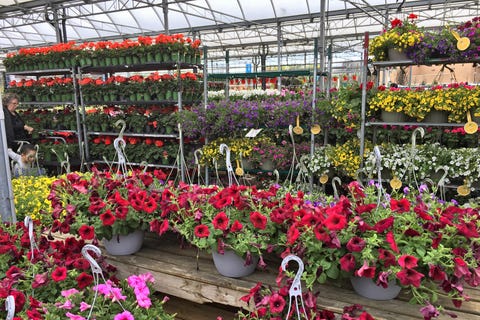When Do You Plant Flowers For A Moon Garden
Weeding and watering—though necessary garden chores—are definitely not as enjoyable as choosing flowers and putting them in the ground. Planting flowers is one of the true joys of gardening! (And it couldn't be easier, even for beginners.) There's also something soothing about walking around the garden every day to observe your plants and all the pretty, little pollinators doing their jobs.
To get the most bang for your buck when planting flowers, make sure you know what you're buying. Annuals last one season and provide bright pops of color right away all season long until frost. Perennials bloom for just a few weeks early, mid, or late season and typically return year after year. Read the plant tag or description: It tells you what kind of plant it is as well as how much sunlight the flower needs. Full sun is considered 6 or more hours of direct sunlight, while part sun is about half that. If you choose perennials, pay attention to the USDA Hardiness Zones (check yours here) to be sure the plant can survive winters in your climate.
Timing is key fo planting: For most flowers, you'll want to wait until after the last frost of the season to plant, although there are a few types, such as snap dragons and violas, that will handle cooler temperatures.
Here's how to plant flowers that will brighten your garden now and for years to come:
Prep your beds or pots.
If you're adding flowers to a garden bed, dig out the area ahead of time. Mix in some compost to improve the soil structure. Pull weeds now so they won't compete for water and nutrients with the plants you do want! If you're planting in containers for your patio, deck or balcony, fill to within an inch or two of the rim with potting mix (not garden soil, which isn't the same thing). For mixed containers, choose one type of plant that's tall, such as marigolds or daisies to provide vertical interest, something to fill out the pot such as calibrachoas or petunias, and something to spill over the edges, such as sweet potato vine or fan flowers.
Pay attention to plant size.
The plant tag or description will tell you how tall and wide a plant is expected to get under ideal conditions. Don't ignore it! If you're planting in beds, you want to put the tallest flowers, such as zinnia or salvia, in back, with sprawling flowers or groundcovers, such as sweet alyssum or portulaca, in front.

NurPhoto Getty Images
Choose healthy plants.
If shopping at a nursery, look for plants that appear strong and green, not wilted, brown or already scraggly. If the pots are bone-dry, avoid them because the plants likely are already stressed.
Give your plant a good start.
Dig a hole about twice the size of the root ball. If you have a multi-pack of flowers, squeeze each individual cell to loosen it up a bit. Then tilt the pack on its side, allowing each plant to slip out of its section into your hand. If you need to coax it, that's fine, too. Lift the plant by the stem, not the top, and set in the hole at the same depth it was in the pot. You also can rough up the roots (gently!) with your fingers a bit to help them start spreading out into the hole because roots often are matted and circled inside the pot when you buy them. Replace the soil around the plant in the hole, tamp it lightly, and water thoroughly.
Pay attention to planting times for seeds.
If you're planting seeds, read the package to see how deep to plant them. It's often surprisingly shallow, perhaps as little as a ¼ inch. And pay attention to the "days to maturity" listed on the package as well. For example, if a flower takes 80 days to mature and it's already the end of June, it may be too late to plant from seed in some climates. You'll spend all summer watching your plant grow but never bloom, only to get taken out by the first frost!
Mulch your new plantings.
It may seem like an unnecessary step, but mulch (even in a container) will reduce evaporation so you may be able to water less frequently. It will also keep down weeds and decompose over time, improving soil structure.

picture alliance Getty Images
Don't forget to water.
Most annual and perennial flowers need a couple of inches of moisture per week to thrive. But use common sense: If it's rained, you probably don't need to water! If you stick your finger in a pot and it's dry, it's time to give it a drink. Most plants prefer long, deep watering until water runs out of the bottom of the pot. In spring, with frequent rains, expect to water pots and beds a few times a week. In the summer, you'll probably need to water daily. By fall, the growing season is ending so water a couple of times a week during dry spells.
What You Need to Plant Flowers
Follow House Beautiful on Instagram.
Arricca Elin Sansone Arricca SanSone has written about health and lifestyle topics for Prevention, Country Living, Woman's Day, and more.
This content is created and maintained by a third party, and imported onto this page to help users provide their email addresses. You may be able to find more information about this and similar content at piano.io
When Do You Plant Flowers For A Moon Garden
Source: https://www.housebeautiful.com/lifestyle/gardening/a32702349/how-to-plant-flowers/
Posted by: myersborceir.blogspot.com

0 Response to "When Do You Plant Flowers For A Moon Garden"
Post a Comment